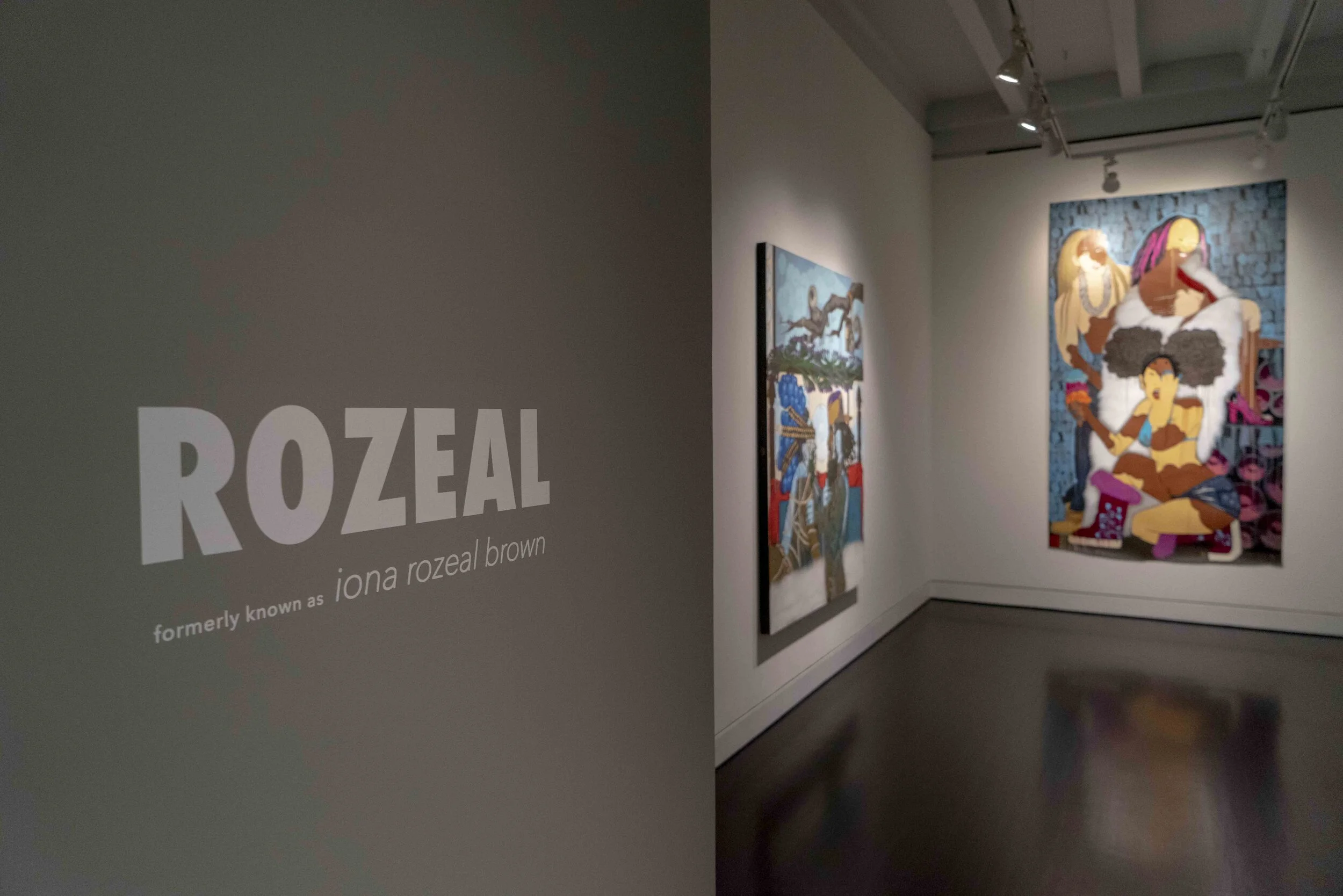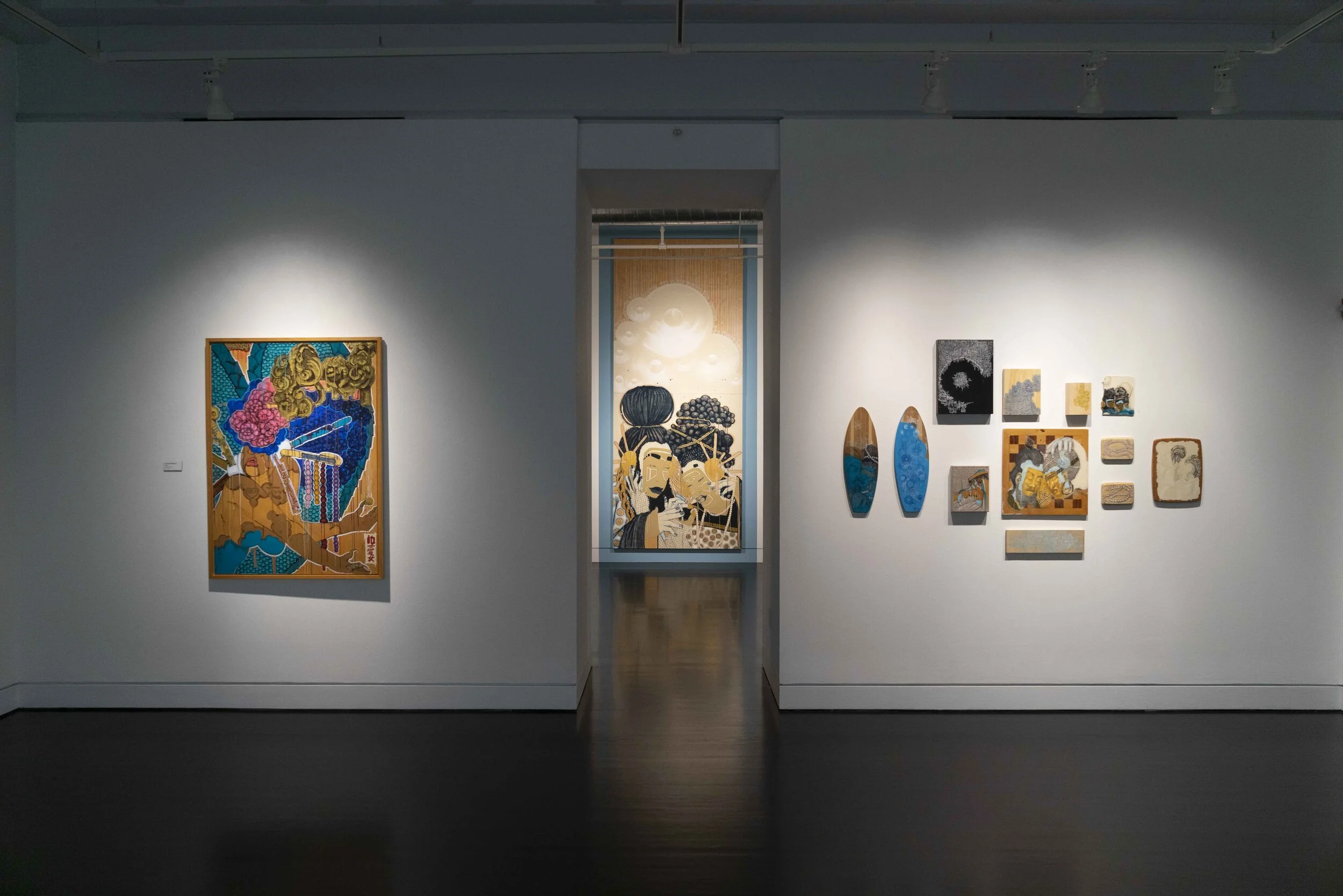ROZEAL
Terzo Piano’s second solo exhibition features nationally recognized artist Rozeal, formerly known as Iona Rozeal Brown.
The show consist of new and old mixed media works in her iconic mash-up style of traditional Ukiyo-e aesthetics with contemporary hip hop culture.
The show is open now through February 14th. Viewings are available by appointment only. Click the button below to schedule your private viewing.
Photos by Wyatt Reid Westlund
Interview with Rozeal
Director and founder of Terzo Piano, Giorgio Furioso, discusses the Exhibit "Rozeal - Formerly known as iona rozeal brown" with the artist.
Exhibition Introduction
by Giorgio Furioso
It is so exciting to have a solo show here at Terzo Piano featuring the work of Rozeal—formerly known as iona rozeal brown. Though her name is now simpler, there is nothing simple about Rozeal. After reassessing her pictorial approach, Rozeal has found new ways to express her ideas while retaining many of the original impulses behind her work.
Much has been written about Rozeal’s visual inspirations and the convergence of Japanese and African American cultures in her work. Having known Rozeal and her work for a few decades, I see more than a visual surface. Within her paintings lies a narrative—one so full of autobiographical detail it could be called a diary—rife with both hidden and not-so-hidden meanings.
Like the artist herself, the physical work combines multiple mediums and surfaces, creating a visual harmony whose effect, in its totality, is both dynamic and exciting. And just as Japanese Ukiyou-e woodblock prints reveal the wood behind their creation, Rozeal’s technique of selectively allowing paint to drip often brings the paint itself to the fore.
Pleasure was a central theme of those Japanese prints. In Rozeal’s work, pleasure may or may not be depicted, but it is always complicated—and sometimes disguised—by personal iconography. And while Rozeal’s painting is of our time, the wonderful, historical references it makes to a time and culture alien to ours gives it a depth of expression, and speaks to the artist’s own sense of alienation as well.
In the end, no matter what meaning one might extract from this body of work, it remains simply beautiful to encounter and behold. In that respect—like Ukiyo-e—it ultimately embodies and conveys pleasure, but it arrives there through a deeply personal path.
ROZEAL
by Rhea Combs
Painters, why do you always paint white virgins? Don’t you know there are beautiful Black angels in heaven also? Painters, paint beautiful Black angels. –Roberta Flack (1969)1
Rozeal (previously known as iona rozeal brown) is the artist’s first solo exhibition in seven years and is a culmination of work produced over the course of nearly a decade. 2 Rozeal (b. 1966) burst onto the art scene as iona rozeal brown to much fanfare after receiving an MFA from Yale University’s School of Art in 2002. Highly influenced by Japanese artist Kitagawa Utamaro (1754–1806), her neat and brightly painted ukiyo-e like drawings of highly stylized, beautifully coifed models in blackface, or ganguro, were figurative, fun and colorful, but also smart and complex. The work examined the confluence of African American and Asian cultures––the similarities, contradictions and appropriations that come from cross-cultural fascinations. Her intersection of hip-hop culture and Asian tradition was a perfect marriage of the past and the present. Within a short period, she was receiving critical praises for her “provocative treatment of identity and race.”3 Galleries and collectors were acquiring her paintings, and she was busier than she had ever been.4 The Washington, D.C. native soon left Chocolate City for The Big Apple. But Rozeal recoiled at the notion of being contained to a singular idea, despite its popular appeal. Other ideas competed for Rozeal’s creative attention; and like many creatives and artisans before her, she painted on found objects, discarded wood, and other surfaces with the compulsion and urgency of someone who does this because they must, not necessarily for fame and fortune.
Rozeal has been shifting the narrative for BIPOC (Black indigenous, and people of color) long before the term became popular. And while Rozeal’s affinity to music and DJ culture remains steadfast, some of the ostentatiousness of hip-hop culture has been replaced with its essence––the music (or at least the mechanisms that play the music) and its significance. Gold’n Browns of, uh…’Merica (illustration proposal #2 for the Tanning of America by Steve Stout) (2015) is a drawing on cardboard that reimagines the Statue of Liberty as Native American and holding a Boombox in her left hand and a microphone and set of headphones in her right. In this sense, the creation and sound of the music are symbols of freedom. In World Whirl Sounds (Poster for Manchild/Libation Party) (2015), a painting on craft paper with speakers surrounding the Earth, art and culture make the world go round. Speakers appear by themselves in some paintings; they show up abstracted in other places. They are also incorporated into paintings with couples, offering a likeness to halos often seen in works from the Italian Renaissance period. Throughout, the culture of the marginalized serve as liberatory forces in this life and the imagined world.
Pearls are another recurring motif for Rozeal, and like the speakers, are presented by themselves or draped around couples. An heirloom from her mother and great-aunt––her namesakes––they represent the family that is no longer physically present. The actual pearl necklace has been misplaced therefore the painted ones are particularly meaningful. The decorative becomes a reconciliatory gesture for Rozeal who simultaneously engages with the abstract and figurative by creating an imagined Afro-futuristic reality anchored in the past and filled with beautiful black angels.
The scale of much of Rozeal’s current work has shifted. Tyvek, cardboard, Hallmark cards, discarded wood, chessboards and other surfaces have replaced the large-scale acrylic drawings on paper that predominated much of her previous work. Many of her paintings now reflect an interiority and explore questions Rozeal is currently asking herself. A reverence for love is apparent in works in several untitled works as well as Caruso a la Luciano (2020), True Majesty, True Faith, New Order (2014–2020), and Freddie Grey’s Grey Matter Matters (2016–2020), for instance. The subtle gestures and tender embrace seen in many of the couples––sketches of idealized love figures––are incorporated with non-representational components suggesting that what appears sanguine on the surface is more complicated. There is a soulfulness and longing among the couples Rozeal paints; it feels honest and mature, perhaps slightly vulnerable. “The couple is based on a Chinese Emperor who was so in love with his courtesan that he lost his kingdom,” explains Rozeal. The thin lips and caricatured features seen in previous work are now replaced by full-lips and wide noses. Hairstyles that served as a critique on appropriation and exaggeration are replaced by dreadlocks, beards, and tight coils adorned with gold embellishments and tattoos. Pristine, ageless models are seen as more mature and full-body figures, reflected by a few untitled works, as well as the Rozeal on Rothko (2018–2019) drawings and the triptych, Barbie Cue (2010– 2018).
Rozeal’s observations display a keen awareness of the style and rhythms of popular culture, so it is no accident that gender fluidity is represented in The Oobie Kids (2012), and that the perfected lines and shapes in earlier works now include obvious paint drips. One might consider the latter effect an homage to hip-hop and graffiti culture. Rozeal says this is an aesthetic choice that is more aligned with her personality; it allows her to work faster, and make what she considers “intentional mistakes.” Overall, it offers an additional layering to her figurative and abstract works without abandoning the essence of her artistic practice. In the end, Rozeal finds beauty in the complicated, discarded, and disregarded because it exposes what matters most to her: love. This current body of work is audacious. It shows a mid-career artist daring to chart her own course by exploring ideas near to her heart. In a world that finds it beneficial to compartmentalize people, especially artists, Rozeal refuses such confinement. Life is her muse, and the ways she expresses her reality is not fixed––nor should it be.
NOTES
1 Flack, Roberta, “Angelitos Negros,” First Take. Atlantic Records, 1969, Track 2. https://www.kcet.org/shows/ artbound-presents-studio-a/roberta-flack-performs-angelitos-negros, accessed November 28, 2020.
2 Edward Tyler Nahem Fine Art in New York City presented iona ROZEAL brown: no one’s ever gonna love you, so don’t wonder, February 28–March 29, 2013.
3 Kennicott, Phillip. “Artist melds art forms, eras and disparate cultures in provocative works.” Washington Post, December 28, 2011, https://www.washingtonpost.com/lifestyle/style/artist-melds-art-forms-eras-and-disparate-
cultures-in-provocative-works/2011/12/23/gIQAV3m7MP_story.html, accessed November 16, 2020.
4 Spelman College Museum of Fine Art in Atlanta, GA presented Rozeal’s first solo exhibition, a3…black on both sides in 2004. Rozeal has had solo exhibitions at the Corcoran Gallery of Art, Washington, DC. MoCA Detroit, MoCA Cleveland, and the Wadsworth Atheneum Museum of Art, Hartford. Her work is in the permanent collection of numerous museums including the National Gallery of Art, Washington, DC and Smithsonian’s National Museum of African American History and Culture, and numerous private collections.
Rhea Combs is a museum curator who lives and works in Washington, D.C.








